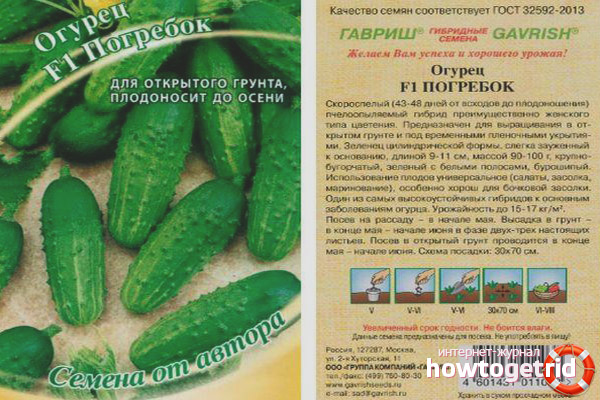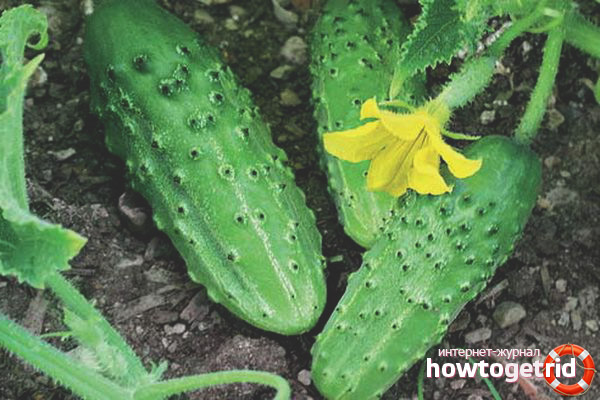The content of the article
One of the most popular vegetable crops in our gardens is cucumber. Its nutritional value is great, especially in early summer, when the body needs vitamins. Breeders are constantly breeding precocious varieties of cucumbers. Variety Pogrebok has a hybrid origin, therefore it is characterized by unpretentiousness to weather conditions and high rates in harvesting. The variety was obtained by crossing two different species. It has excellent taste, good resistance to diseases and pests, cucumbers ripen early. The variety is intended for cultivation under film shelters and in open beds.
Grade description
The bushes are small, the lashes have limited growth, reach 60-70 cm in length. It is recommended to tie the lashes to the support. The leaves are green, wide, on the surface there is a dense pubescence. Ripening period begins 45-49 days after sowing seeds. Seeds do not preserve the genetics of the parent, so collecting them yourself does not make sense. Seed material is purchased in a specialized store every year.
Ovaries form in bundles. More than 10 ovaries are formed on one lash. Fruits of cylindrical shape, narrowed to the base. The average weight of one cucumber is about 100 grams. The fruit grows in length to 11 cm. The peel of the fruit is dense, dark green in color. On the surface, small tuberosity and black spikes are observed. The pulp of the fruit is juicy, crispy, has no bitterness. With moisture deficiency, voids form in the fruits, such cucumbers should not be allowed to prepare workpieces. Variety Pogrebok is a universal vegetable crop. Cucumbers can be pickled, fermented, salted, and also used as a component for fresh vegetable salads.
Growing Features
When planting, observe the distance between neighboring plants. The free space should be 50 cm. For support, you can install a vertical trellis or mesh. Tying the lashes will increase yields and facilitate harvesting.
Care Rules
Plant health and the number of fruits directly depend on the quality of care for the variety. It is important to carry out timely watering of the bushes. Water should not be cold. From this, the roots can be supercooled, and diseases develop. Water should be settled and warmed up in the sun. For watering cucumbers, it is better to prefer drip irrigation. It is important that moisture does not get on the foliage and shoots, but only on the root system. The procedure is preferably carried out in the evening or early in the morning until there is no hot sunlight.
If the soil under the bushes is not mulched, then cultivation is recommended. This will help normalize air exchange in the root system of plants. It is also periodically required to destroy weed grass. Weeds pull useful substances from the earth, which are necessary for cucumbers for full development.
Timely feeding positively affects the growth and development of plants. At different stages of growth, mineral and organic additives should be added. It is strictly forbidden to add fresh manure, first it must be re-heated. As soon as the sprouts appear, you can feed them with nitrate.This will help accelerate plant growth. During the beginning of flowering and during the period of active fruiting, the bushes are fed with ash. It can be diluted with water and watered the roots of the bushes or sprinkled on the ground around the roots. A wonderful economical fertilizer will be watering plants with infusion of weeds. 14 days before fertilizing, the weed grass is poured with water, and put in the sun to insist.
Pest and Disease Control
Despite its high resistance to dangerous viruses and harmful insects, cucumbers can infect some types of pests. The following pests are distinguished:
- Spider mite. With a visual inspection of the bushes, you can see a thin net that entangles the leaves and shoots of plants. This is a spider mite settled. For the fight and for preventive purposes, treatment with special drugs is used. Some insecticides are added during watering, others are used as a solution for spraying plants in the form of a solution.
- Slug and aphids. Unpleasant insects can choose cucumber whips. A good and effective tool is oven ash. It is sprinkled with soil and leaves, and also used as fertilizer in the form of a solution.
Variety of cucumbers Cellar is in demand among gardeners. Attractive appearance and suitability for transportability is taken into account by trading companies, cucumbers are used for transportation to other regions for the purpose of further marketing. Subject to agricultural farming techniques, manufacturers guarantee a good harvest.
Video: cucumber varieties Pogrebok F1











Submit